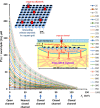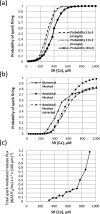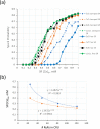Elementary intracellular Ca signals approximated as a transition of release channel system from a metastable state
- PMID: 37744735
- PMCID: PMC10517864
- DOI: 10.1063/5.0151255
Elementary intracellular Ca signals approximated as a transition of release channel system from a metastable state
Abstract
Cardiac muscle contraction is initiated by an elementary Ca signal (called Ca spark) which is achieved by collective action of Ca release channels in a cluster. The mechanism of this synchronization remains uncertain. We approached Ca spark activation as an emergent phenomenon of an interactive system of release channels. We constructed a weakly lumped Markov chain that applies an Ising model formalism to such release channel clusters and probable open channel configurations and demonstrated that spark activation is described as a system transition from a metastable to an absorbing state, analogous to the pressure required to overcome surface tension in bubble formation. This yielded quantitative estimates of the spark generation probability as a function of various system parameters. We performed numerical simulations to find spark probabilities as a function of sarcoplasmic reticulum Ca concentration, obtaining similar values for spark activation threshold as our analytic model, as well as those reported in experimental studies. Our parametric sensitivity analyses also showed that the spark activation threshold decreased as Ca sensitivity of RyR activation and RyR cluster size increased.
© 2023 Author(s).
Conflict of interest statement
The authors have no conflicts to disclose.
Figures






Similar articles
-
Clusters of calcium release channels harness the Ising phase transition to confine their elementary intracellular signals.Proc Natl Acad Sci U S A. 2017 Jul 18;114(29):7525-7530. doi: 10.1073/pnas.1701409114. Epub 2017 Jul 3. Proc Natl Acad Sci U S A. 2017. PMID: 28674006 Free PMC article.
-
Size Matters: Ryanodine Receptor Cluster Size Affects Arrhythmogenic Sarcoplasmic Reticulum Calcium Release.J Am Heart Assoc. 2018 Jun 21;7(13):e008724. doi: 10.1161/JAHA.118.008724. J Am Heart Assoc. 2018. PMID: 29929992 Free PMC article.
-
Superresolution modeling of calcium release in the heart.Biophys J. 2014 Dec 16;107(12):3018-3029. doi: 10.1016/j.bpj.2014.11.003. Biophys J. 2014. PMID: 25517166 Free PMC article.
-
Ca2+ spark as a regulator of ion channel activity.Jpn J Pharmacol. 1999 May;80(1):1-8. doi: 10.1254/jjp.80.1. Jpn J Pharmacol. 1999. PMID: 10446750 Review.
-
Regulation and Role of Store-Operated Ca2+ Entry in Cellular Proliferation.In: Kozak JA, Putney JW Jr, editors. Calcium Entry Channels in Non-Excitable Cells. Boca Raton (FL): CRC Press/Taylor & Francis; 2018. Chapter 12. In: Kozak JA, Putney JW Jr, editors. Calcium Entry Channels in Non-Excitable Cells. Boca Raton (FL): CRC Press/Taylor & Francis; 2018. Chapter 12. PMID: 30299656 Free Books & Documents. Review.
Cited by
-
Disorder in Ca2+ release unit locations confers robustness but cuts flexibility of heart pacemaking.J Gen Physiol. 2022 Sep 5;154(9):e202113061. doi: 10.1085/jgp.202113061. Epub 2022 Aug 9. J Gen Physiol. 2022. PMID: 35943725 Free PMC article.
References
LinkOut - more resources
Full Text Sources
